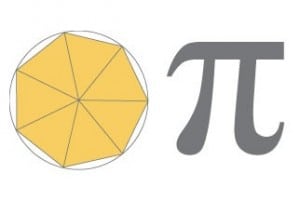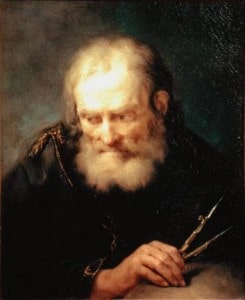On March 14 at 1:59 pm we gather together to celebrate the most famous and mysterious of numbers. That Pi is defined as the ratio of the circumference of a circle to its diameter seems simple enough but Pi turns out to be an “irrational number.” Computer scientists have calculated billions of digits of pi, starting with 3.14159265358979323…, no recognizable pattern emerges in the digits. Scientists could continue calculating the next digit all the way to infinity and still have no idea which digit might emerge next. To these facts can be added that March 14 is also Einstein’s birthday.
Pi is a number that has fascinated scholars for 4,000 years. The mathematical history of pi comes from around the world. In 1900 B.C., the Babylonians calculated the area of the circle by taking 3 times the square of its radius. One Babylonian tablet (ca 1900-1680 B.C.) indicates a value of 3.125 for pi, which is a close approximation. Around 1650 B.C., the Rhind Papyrus, a famous document of the Egyptian Middle Kingdom, also calculated the area of a circle which gave the approximate value of 3.1605.
In 250 B.C., the Greek mathematician Archimedes calculated the circumference of a circle to its diameter. Archimedes value , was not only more accurate; it was the first theoretical rather than measured calculations of pi. Archimedes knew that he had not found the value of pi but only an approximation. He used a fairy simply geometrical approach for his calculations. See how he did it by launching the interactive model on this pbs.org site: http://www.pbs.org/wgbh/nova/physics/approximating-pi.html
Zu Chongzhi (429-501 AD?) was a Chinese mathematician and astronomer, who was not familiar with Archimedes method. He calculated the value of the ratio of the circumference of a circle to its diameter. Unfortunately, his book has been lost so very little is known of his work.
In 1761, a Swiss mathematician Johann Heinrich Lambert (1782-1777) proved the irrationality of pi. An irrational number is a number that cannot be made into a fraction where the decimal never ends or repeat sequences.
By 1882, F. Lindeman proved that pi was transcendental, that is, that pi is not the root of any algebraic equation with rational coefficients. This discovery proved that you can’t “square the circle” which was a problem that vexed many mathematicians up to that time. Another fascination for mathematicians throughout history was to calculate the digits of pi, but until computers, less than 1,000 digits had been calculated. With the calculations of the computer, millions of digits have been calculated.
REFERENCES:
Adiran, Y. E. O. The Pleasures of Pi, e and Other Interesting Numbers. Singapore: World Scientific Pub., c2006. Engineering Library QA95 .A2 2006
Alsina, Claudi. Icons of Mathematics: An Exploration of Twenty Key Images. Washington, D.C.: Mathematical Association of America c2011. http://site.ebrary.com/lib/uiowa/Doc?id=10728529
Beckman, Petr. The History of Pi. Boulder: Colorado: The Golem Press, 1977. Main Math Collection QA484 .B4 1977
Chongzhi, Zu. Encyclopedia Britannica. Encyclopedia Britannica Online. Encyclopedia Britannica Inc., 2014. Web, 10 March 2014. Http://wwwbritannica.com / EBchecked/topic/1073884/Zu-Chongzhi. Main Reference Collection AE5 .E363 2010
Exploratorium. (2014). Pi Day. Retrieved from http://www.exploratorium.edu/pi/
Gillings, R. Mathematics in the Time of the Pharaohs. Boston, MA: MIT Press, 89-103, 1972. Main Math Collection QA27.E3 G52
Gardner, Milo. “Rhind Papyrus.” From MathWorld–A Wolfram Web Resource, created by Eric W. Weisstein. http://mathworld.wolfram.com/RhindPapyrus.html
A facsimile of this papyrus can also be found at the
Main Oversize FOLIO PJ1681 R5 1927
Main Math Collection FOLIO PJ1681 R5 1927
Hobson, Ernest William. Squaring the Circle and Other Monographs. New York: Chelsea, 1953. Main Math Collection QA467 .H62 1953
KHANACADEMY. (2014). A Song About A Circle Constant. Retrieved from https://www.khanacademy.org/math/recreational-math/vi-hart/pi-tau/v/a-song-about-a-circle-constant
Libeskind, Shlomo. Euclidean and Transformational Geometry: A Deductive Inquiry. Sudbury, Mass.: Jones and Bartlett Publishers, c 2008. Engineering Library QA453 .L53 2008
Mackenzie, D. “Fractions to Make an Egyptian Scribe Blanch.” Science 278, 224, 1997.
McCall, Martin W. Classical Mechanics: From Newton to Einstein: A Modern Introduction. Hoboken, NJ: Wiley, 2010. Engineering Library QC125.2 .M385 2011
Robins, G. and Shute, C. The Rhind Mathematical Papyrus: An Ancient Egyptian Text. New York: Dover, 1990. Main Math Collection QA30.3 .R63 1987
Weingardt, Richard. Circles in The Sky: The Life and Times of George Ferris. Reston, VA,: American Society of Civil Engineers, C.2009. Engineering Library TA140.F455 W45 2009

